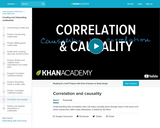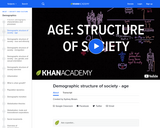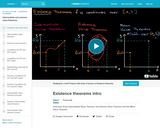
Understanding alternate coordinate systems. Created by Sal Khan.
- Subject:
- Algebra
- Mathematics
- Material Type:
- Lesson
- Provider:
- Khan Academy
- Provider Set:
- Khan Academy
- Author:
- Salman Khan
- Date Added:
- 02/28/2018

Understanding alternate coordinate systems. Created by Sal Khan.

Understanding why correlation does not imply causality (even though many in the press and some researchers often imply otherwise).

According to Pierre Bourdieu, cultural capital is the cultural knowledge that serves as the currency that helps us navigate a culture and alters our experiences and the opportunities available to us. This theory focuses on the embodied, objectified and institutionalized states of capital and is significantly important in assisting us in understanding inequality in education and other social structures. Further explanation of cultural capital can be found on page 365 of the Sociology 2e text by OpenStax College.

Sal discusses the conditions of matrix dimensions for which addition or multiplication are defined. Created by Sal Khan.

Principles of dynamic delivery, and how to select and use presentation aids.

In this episode of the Economic Lowdown Video Series, economic education specialist Scott Wolla explains the concept of demand. Viewers will learn how a change in the price of a good affects the quantity of the good consumers will buy and how changes in market conditions affect the demand for a good.

Sociology often looks at different age cohorts. A cohort is simply a group of people, but here we're looking specifically at different age groups or generations, because these people all lived through the same certain events through a certain time that affected their lives similarly.

Dimension of the Column Space or Rank. Created by Sal Khan.

Dimension of the Null Space or Nullity. Created by Sal Khan.

This video defines the differences between discrete and continuous random variables, then works through examples of each.

Discrimination can be defined in two ways: individual and institutional. Individual discrimination refers to the prejudiced behavior of one person, while institutional discrimination refers to the way an organization's rules or policies disadvantage certain groups. Although they are distinct, these two forms of discrimination can be interconnected. Individual discrimination can be reinforced by institutional policies, and vice versa, which leads to a larger, systemic issue. (. Created by James Howick.

Emotions don’t just feel good or bad, they also contribute crucially to people’s well-being and health. In general, experiencing positive emotions is good for us, whereas experiencing negative emotions is bad for us. However, recent research on emotions and well-being suggests this simple conclusion is incomplete and sometimes even wrong. Taking a closer look at this research, the present module provides a more complex relationship between emotion and well-being. At least three aspects of the emotional experience appear to affect how a given emotion is linked with well-being: the intensity of the emotion experienced, the fluctuation of the emotion experienced, and the context in which the emotion is experienced. While it is generally good to experience more positive emotion and less negative emotion, this is not always the guide to the good life.

Where we live in society plays a huge role in the environmental benefits and risks that we're exposed to.

Arnold Kling joins us to talk about his new book, Specialization and Trade, which was recently published by Libertarianism.org.
What’s the “MIT” approach to economics, and what’s wrong with it? Is economics a hard science? What is an economic model? What are some of the problems with thinking of the world this way?
Arnold Kling claims that the economy isn’t like one big machine with a single purpose that can be fine tuned and regulated by experts. In this week’s episode, he presents an alternate way of thinking about economics, one you won’t find being taught in most college classrooms.

In this episode of the Economic Lowdown Video Series, economic education specialist Scott Wolla explains the concept of equilibrium. Viewers will get a refresher on the laws of supply and demand before they learn about market equilibrium – the point at which there is no shortage or surplus of a good or service.

Compare distributions using the features of shape, center, spread, and outliers.

Overview of the Intermediate Value Theorem, the Extreme Value Theorem and the Mean Value Theorem.

If you haven’t discovered already, there are myriad open resources that exist. Often the trouble lies in locating those that fit precisely what you need. We’ve broken down these resources with the intent of making the search process more efficient and effective. For each you’ll find a list of unique traits, licensing information, and an example of how to attribute the source. Click one of the media sources in the Find Resources sub-menu for the details.

Here’s the third chapter of our mini-series on business cycle theories: The Real Business Cycle.

For an introduction to mindfulness meditation that you can practice on your own, download the UCLA Mindful App (iTunes / Google Play), stream, or download the guided meditations below. Recorded by UCLA MARC's Director of Mindfulness Education, Diana Winston.